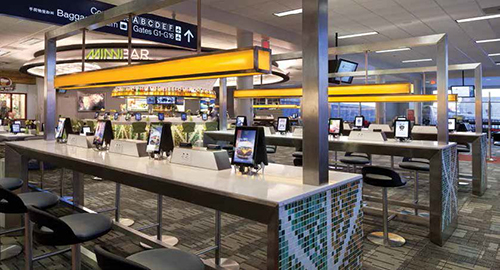Minneapolis-St. Paul Int'l Encourages Travelers to Sit Down & Power Up
 Authorities at Minneapolis-St. Paul Int'l Airport (MSP) understand that little things can have a big impact on passengers' overall travel experience. That's why they recently invested $1 million to update seating throughout Terminal 1 and plan to follow up with another wave of similar improvements later this year.
Authorities at Minneapolis-St. Paul Int'l Airport (MSP) understand that little things can have a big impact on passengers' overall travel experience. That's why they recently invested $1 million to update seating throughout Terminal 1 and plan to follow up with another wave of similar improvements later this year.
While travelers once had to search for outlets to power up their electronic and mobile devices, they now have outlets available almost anywhere they decide to sit. At some gates, there are even iPads available to use for free.
"Over the past eight years or so, we've seen travelers plugging into any available outlet to run and recharge their devices," explains MSP Senior Airport Architect Allan Howell. "Perhaps they've been running their laptop for the past four hours and now they have a layover but they are running out of power. (They) sit on the floor next to any available outlet, which creates safety concerns with passenger carts and people walking by. We didn't want customers to have to hunt for an outlet; we wanted them to plug into an outlet near where they are sitting, a place they can easily find and makes sense to them."
Traditional sling seating, developed in the mid-1950s, was a good, functional product that served its intended purpose; but the ways travelers spend their time in airports have changed dramatically over the years, Howell reflects. Travelers now arrive earlier and have longer wait times, he notes. Long lines at security checkpoints and the associated juggling of shoes, belts, bags and sundry personal items test their patience. When passengers make it to the post-security areas, many are eager to work or play via one of the many electronic devices that keep them connected to the pre-security world.
Ahead of the Curve
In 2009, MSP established a capital improvement program to upgrade public seating throughout Terminal 1. The beam units ranged between 20 and 40 years old.
"It was time for us to replace it," Howell states. "We understood that whatever choice we make will likely be there for the long term; so it needs to be a good one."
Integrating power into the seating was a priority. But when MSP personnel began evaluating new product options in 2010, they couldn't find a manufacturer that offered beam seating with power connections. When they described what the airport needed, manufacturers brought in prototypes.
Originally, MSP officials wanted to provide power access in all of its seats, recalls Howell. Advances in battery technology over the past several years, however, changed their minds.
The airport is taking a phased approach to the project. During Phase 1, completed in August, crews installed 202 beam seats throughout the Mall, Concourse C and international arrivals meet-and-greet areas. Tables interspersed in the center of two-, three- and four-seat arrangements provide a pair of three-prong AC power outlets and a USB connection.
Nearly 90 lounge seats (44 new, 44 existing) also provide power at 44 granite-topped tables in the Mall, concourses C and D, and the international arrivals meet-and-greet areas. Crews also added tiered lounge seating and sofa seating in the terminal's short film and performance space and sofa seating in the restroom waiting areas on Concourse C as well as in the Mall and Concourse C tram station entrances.
In addition to providing new seating arrangements, MSP is in the process of redesigning the airport's service centers. A prototype featuring a countertop and conversational area
has been installed on Concourse C. Telephone banks were removed years ago due to the proliferation of cellphones and mobile devices.
In the food court, new power connections along countertops allow travelers to use and charge their devices while they eat. Plans are in the works to test similar countertop seating in gate areas next year. "Rather than having just beam seating
 factsfigures factsfiguresProject: Seating Overhaul Location: Minneapolis-St. Paul Int'l Terminal: 1 Cost: $1 million (Phase 1) Architectural Design & Consultation: Architectural Alliance, (now Alliiance) Construction Manager: Kraus-Anderson Construction General Contractor: Morcon Construction Mechanical & Electrical Design: Michaud Cooley Erickson Concourse G Restaurant & Retail Management: OTG Management Seating & Table Manufacturers: Allsteel; Coalesse; Davis Furniture; Elevate vis Furniture; Martin Brattrud; Vitra; Zoeftig Noteworthy Detail: 1,700 iPads added for free passenger use near Delta gates in Concourse G |
with available power, we'd like to offer work areas where people can still hear and see if their plane is boarding or delayed,"
Howell explains.
Phase 2 of the project will add 488 more beam seats with powered tables throughout Concourse E - in gate areas, near taxi and shuttle stands and in the rental car and ticketing areas. MSP officials expect it to be complete in February 2015.
Residential Touches
Architectural Alliance (now Alliiance) worked to infuse some "comforts of home" when redesigning the public seating areas in Terminal 1. "We created living room-like zones in the Mall area that reside on area rugs and feature a combination of soft lounge seating with power tables and various arrangements of powered beam seating," explains Susanna Strand, one of the firm's associates. "Along the C concourse, in between the moving walks, are relaxation nodes enhanced by pendant lights, powered beam seating and soft lounge chairs with powered side tables."
April Meyer, an Alliiance principal, notes that MSP's vision for new seating exemplifies its commitment to the passenger experience. "People have different needs and desires while waiting for their flights," Meyer relates. "The public seating project identifies the varying aspects of traveler needs and accommodates them in a variety of ways. Whether travelers wish to read a book or work, we want to give them choices throughout the public spaces."
In earlier years, MSP passengers could recharge devices for a fee at vendor kiosks. Then airlines began providing free power through shared power-pole charging stations at various gates. Food courts and full-service restaurants followed suit, offering places for customers to plug in and charge up. Power seating was the next logical step.
"Our biggest challenge is understanding the long-term needs of our customers," Howell summarizes. "We know what we see today; we understand what we've seen historically; but it's hard to project the future. How do we develop public spaces that are flexible and amenable to the needs of travelers? We will continue to adapt. For now, we just want to make sure that the time folks spend in the terminal is productive and enjoyable for them."

|
Eat, Play, Work
Passengers heading to gates 1 through 6 in Concourse G at Minneapolis-St. Paul International Airport may do a double-take when they find themselves in the CIBO Express Gourmet Market. They quickly realize, however, that they didn't misread the signs. Delta Airlines and OTG Management, together with the Metropolitan Airport Commission, have reimagined the very concept of holdrooms by breaking down boundaries in the gate area and blending spaces for sitting, dining, shopping, working and playing. After passengers pass through the market, they enter into a pod of six Delta Airlines gates, which is outfitted with a restaurant and mini-bar at the edge. The shared seating area includes a mix of high and low tables - all with USB and power outlets. Traditional beam seating lines the perimeter and includes numerous beverage holders and USB/power outlets. The most unexpected bonus, however, is a generous supply of iPads - free for passenger use. At about 80% of the seats in the gate area, travelers can sit down, check their email or flight status, review social media postings, play games, etc. - with no obligations attached. If passengers choose, they can use the iPads to order and pay for concession items for tableside delivery; but they are also welcome to simply sit down and use the tablets without incurring any costs. In total, more than 1,700 iPads were installed, reports Sean Aziz, director of communications for OTG Management. All of the high and low tables feature iPads as well as USB/electric outlets. While the iPads connect passengers with MSP concessions (food/beverage and retail), they did not replace human employees. In fact, OTG doubled the number of servers on hand when it introduced the iPads, reports Aziz. "While the iPad facilitates the orders by shooting them straight back to the kitchen, servers, in addition to delivering food, help customers navigate the iPad experience. Rather than being the order taker, they serve a hospitality function," he explains. "And if passengers just want to sit at the table and wait for their flight, perhaps browse through their email or play a game, that's their choice." Aziz considers the gate area the single largest piece of real estate inside an airport and one of the most desirable locations for customers to congregate. When designing the space in MSP's Terminal 1, OTG worked to maintain or increase the gate area's aisle space and seat count. The high and low tables selected allow passengers to slide carry-ons beneath the table, thus clearing more aisle space. "Not only is it a great design in terms of customer amenities, it's functional," Aziz relates enthusiastically. "We've created new revenue opportunities for vendors and a more enjoyable experience for travelers, who no longer have to go to their gate and sit like they are waiting for a root canal." |
FREE Whitepaper
Fairbanks International Airport Baggage Transport Conveyor Enhanced With Mod Drive™ System
Airports face a host of unique industry challenges, such as meeting efficiency regulations and seeking out the best maintenance practices to reduce costs and keep operations flowing. In today’s current economic climate, any potential cost savings can go a long way.
In 2019, Alaska’s Fairbanks International Airport (FAI) sought to modernize its equipment and operations. They were dissatisfied with the performance of the gearmotors on their baggage transport conveyors and began searching for new suppliers. Regal approached FAI with a solution that could improve equipment performance and simplify maintenance, with the added benefit of energy cost savings: the Hub City® MOD Drive™ system.
This white paper discusses the hardware deployed, the test results and the annualized expectations for ROI.








